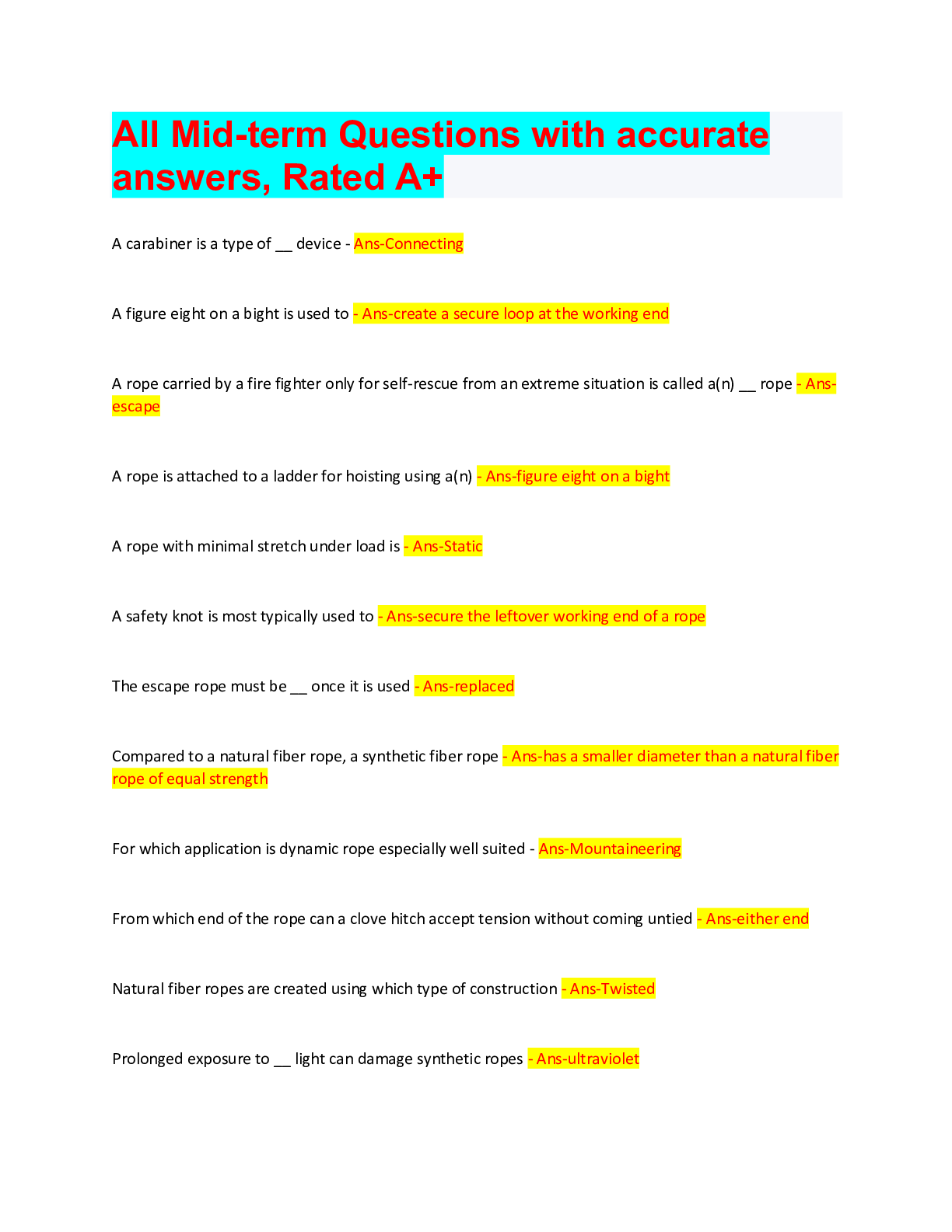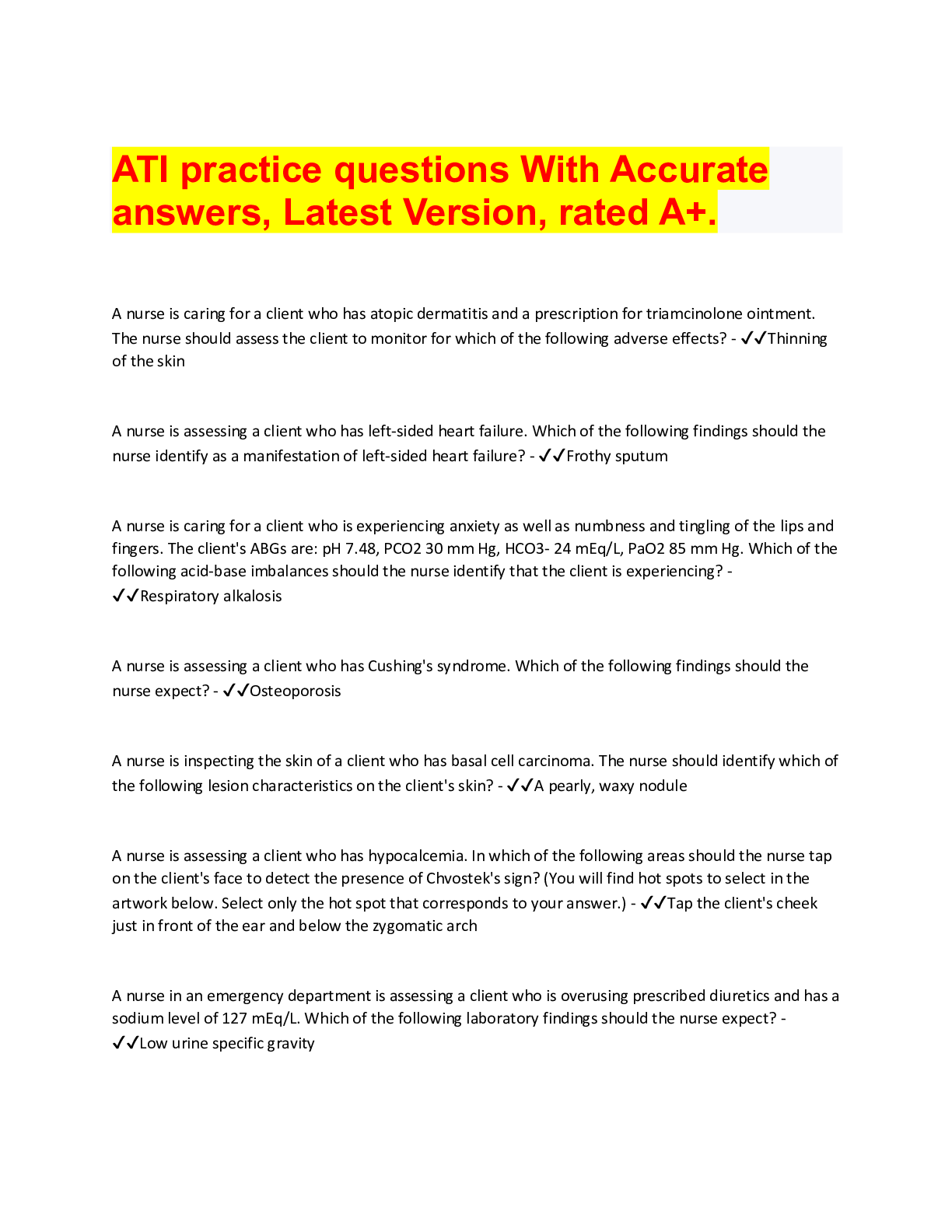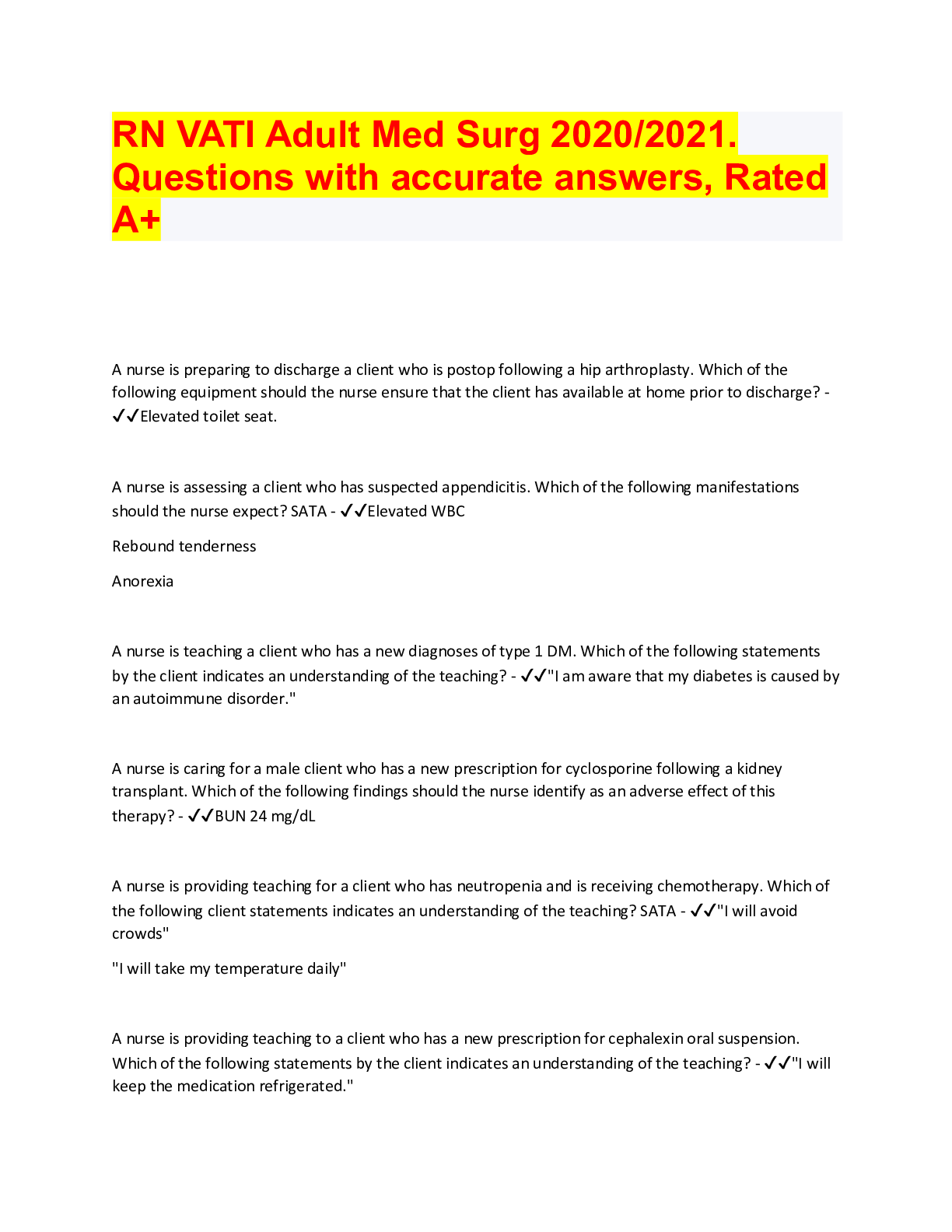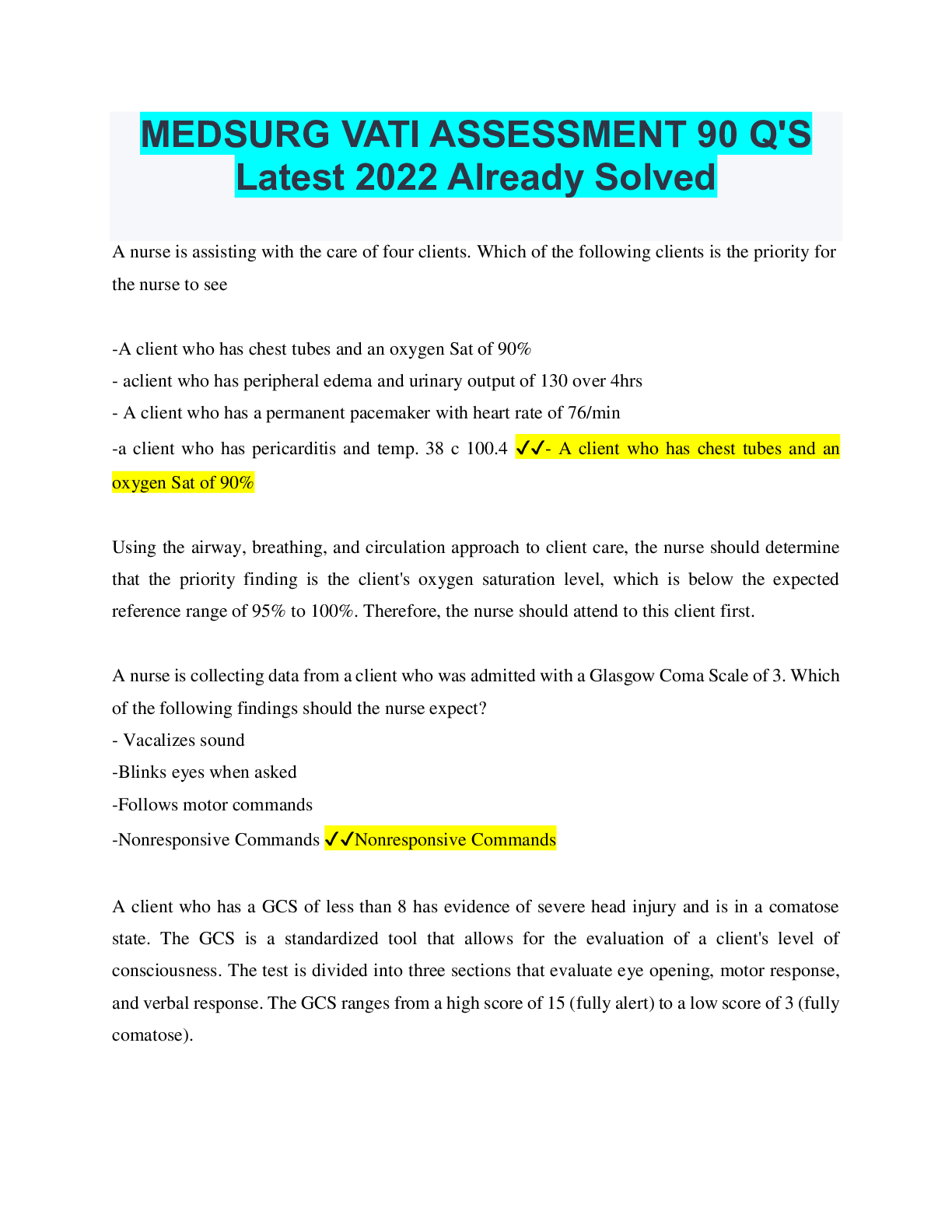Physical Education > QUESTIONS & ANSWERS > ACE Personal Trainer Exam Questions with accurate answers, Rated A. 2022/2023 (All)
ACE Personal Trainer Exam Questions with accurate answers, Rated A. 2022/2023
Document Content and Description Below
ACE Personal Trainer Exam Questions with accurate answers, Rated A. 2022/2023 Static Stretching - ✔✔Most common stretching technique -Extending the targeted muscle group to its max point an... d holding it for 30 sec or more. 2 Forms: -Active- Added force is applied by the individual -Passive- Added force is applied by an external force Dynamic Stretching - ✔✔-Continuous movement patterns that mimic the exercise or sport to be performed. -Purpose is to improve flexibility for a given sport or activity Ballistic Stretching - ✔✔-Used for athletic drills -Repeated bouncing movement to stretch targeted muscle group. -Triggers stretch reflex and may increase risk for injury -Safe if done from low to high-velocity and followed by static stretching Active Isolated Stretching (AIS) - ✔✔-Held only 2 seconds at a time. -Several sets with specific # of reps and gradually increase resistance by a few degrees each rep Myofascial Release - ✔✔-Uses a foam roller (or something similar) -Relieves tension and improves flexibility in the FASCIA (system of connective tissues that covers the whole body) and underlying muscle. -Small continuous back-and-forth movements -Over an area of 2-6 in. for 30-60 sec -Amount of pressure is determined by client's pain tolerance Proprioceptive Neuromuscular Facilitation (PNF) - ✔✔-Use of AUTOGENIC and RECIPROCAL inhibition -3 forms: -Hold-Relax -Contract-Relax -Hold-Relax with agonist contraction Hold-Relax PNF - ✔✔1) Passive 10-sec pre-stretch 2) Hold and resist applied force, causing isometric contraction in the target muscle group, for 6 secs 3) Relax muscle group and passively stretch; hold for 30 sec to increase ROM 4) Greater stretch in final phase due to AUTOGENIC inhibition Contract-Relax PNF - ✔✔1) Passive 10-sec pre-stretch 2) Trainer applies resistance, counteracting client's force of concentric contraction of target muscle group, w/out completely restricting joint through its ROM. 3)Relax muscle group and passively stretch; hold for 30 sec to increase ROM 4) Greater stretch during final phase due to AUTOGENIC inhibition Hold-Relax with Agonist Contraction PNF - ✔✔1)Relax muscle group and passively stretch. 2) Concentrically contract opposing muscle group (of muscle group that's targeted); hold for 30 sec to increase ROM 3) Greater stretch during final phase due to RECIPROCAL and AUTOGENIC inhibition Health Risk Appraisal - ✔✔-A screening that addresses: -signs and symptoms of disease -risk factors -family history -Info can help ID the presence of CVD, Pulmonary, or other diseases. PAR-Q - ✔✔-Brief, self-administered medical questionnaire -Safe pre-exercise screening measure for low-to-moderate (but not vigorous) exercise training ACSM Risk Stratification - ✔✔-More comprehensive risk-factoring process -Determined by # of points. - 1 or less is LOW-RISK - > or =2 is MEDIUM RISK - Being symptomatic or having known disease is HIGH RISK Suggestions for Low-Risk Individuals - ✔✔-Medical exam or Doctor supervision is not necessary - Suggestions for Moderate-Risk Individuals - ✔✔-Medical exam is not necessary for moderate exercise but is recommended for vigorous exercise. -No doctor supervision necessary for submaximal test but is recommended for maximal test. Suggestions for High-Risk Individuals - ✔✔-Medical exam and doctor supervision is recommended Moderate-Intensity Exercise - ✔✔-40-60% of VO2R (VO2 Max - resting VO2) or HRR -VT1 is recommended upper limit Kinetic Chain - ✔✔-Combination of several successively arranged joints making a complex motor unit. -Either open or closed. Open Kinetic Chain Movement - ✔✔-Combination of successively arranged joints that's DISTAL aspect of extremity (end of chain farthest from body) moves freely and is not fixed to an object. -I.E. Seated leg extension, Leg Curl, Bench Press, Dumbbell Biceps Curl, Lat Pull-Down Closed Kinetic Chain Movement - ✔✔-DISTAL segment has external resistance and it restrains movement -Distal end of extremity is fixed, emphasizing joint compression and stabilizing the joint. -Considered more functional . -I.E. Squat, Leg Press, Wall Slides, Lunges, Elliptical Training, Stair Stepper, Versa Climber, Push-ups The Thomas Test - ✔✔-Quick/Simple assessment that examines length of muscles involved in hip flexion -Length helps determine tightness of primary hip flexor muscles (RECTUS FEMORIS, ILLIOPSOAS, ILLIOTIBIAL band) 1) Have client sit on bench/table on their ISCHAL TUBEROSITY (the boney point we normally sit on) 2) Take client back until lying in supine position w/ less than 1/2 the thigh off bench/table. LUMBAR region of back in contact w/ bench 3) Have client bring both knees toward chest and then release 1 leg so it's extended and touches bench Good Flexibility in the ILLIOPSOAS - ✔✔Assessment of Thomas Test - -What it means when client's lower leg touches the surface...? The individual has tight hip flexors (including RECTUS FEMORIS, ILLIOPSOAS, and ILLIOTIBIAL BAND). - ✔✔Assessment of Thomas Test - -What it means when client's back of the leg is even slightly off the surface...? Tight RECTUS FEMORIS (crosses the hip and knee joint) - ✔✔Assessment of Thomas Test - -What it means when client's knee is bent 70 degrees or less The ILLIOTIBIAL BAND is tight - ✔✔Assessment of Thomas Test - - What it means when client's leg abducts or is angled outward during the test False positive of the Thomas Test - ILLIOPSOAS will appear tight when not - ✔✔If client is pulling their knee toward chest too far and there's a posterior tilt of pelvis, it will be a ... False negative of the Thomas Test - hip flexors with appear fine when they aren't - ✔✔If client is not pulling their knee back far enough, is lifting the LUMBAR back off the surface (LORDOSIS), or creating a posterior pelvic tilt, it will be a ... Don't perform the Thomas Test - ✔✔Before assessing your client, ask if they have a sore or injured back. If they answer yes ... Posture - ✔✔-Biomechanical alignment of individual body parts and orientation of the body Balance - ✔✔-Maintaining body's position over it's base of support (BOS) w/in stability limits Lordosis - ✔✔-Increased anterior lumbar curve (bottom and belly out) -Lead to tension on the spine and low-back pain. (A Big Lord with a Big Belly) Kyphosis - ✔✔-Increased posterior thoracic curve (round shoulders like hunchback) --Commonly seen in older adults w/ OSTEOPOROSIS (Has an "H" in the name, stands for "Hunchback") Flat Back - ✔✔-Decreased anterior lumbar curve (normal inward curve of back) -Head exhibits a forward tilt. Sway Back - ✔✔-Decreased anterior lumbar curve -Increased posterior thoracic curve -Rounded shoulders, sunken chest, and forward-tilted head. (Femur and head are farther forward than in kyphosis, and greater posterior deviation) Scoliosis - ✔✔-Excessive lateral spinal curvature -More prevalent in women -May cause pelvis and shoulders to be slightly uneven Fatigue Postures - ✔✔-Caused by stress, pain, injuries, or exhaustion from daily activities -Results in temporary LORDOSIS or KYPHOSIS Predicted 1 Repetition Max (RM) Assessment - ✔✔= (lbs client can lift) x (Coefficient for # of reps completed) Trial 1 Repetition Max (RM) - ✔✔= (Weight of 3rd set) / (the % of 1 RM determined) Actual 1 Repetition Max (RM) Assessment - ✔✔1) Client warms up and begins light resistance (50% 1 RM) 10 reps or less and then rest 1 min 2) 2nd set increases weight to 70-75% of 1 RM and decrease # of reps (3-5) and rest 1 min 3) 3rd set 85-90% of 1 RM for 2-3 reps, and rest 2-4 min Autogenic Inhibition - ✔✔-GTO is activated by force on muscle tendon -Relaxation of agonist muscle and Contraction of antagonist -Seen during static stretching (i.e. low-force, long- duration stretch) Reciprocal Inhibition - ✔✔-Relaxation of antagonist muscle and contraction of agonist muscle. -Seen during dynamic stretching. Sagittal Plane - ✔✔-Divides body into left and right halves. -Any forward/backward movement parallel to line occurs in this plane -Movements: FLEXION, EXTENSION, DORSIFLEXION, & PLANTAR FLEXION. -I.E. Bicep curl, forward, or reverse lunges Frontal Plane - ✔✔-Divides body into front/back halves -Any lateral (side) movement parallel to line occurs in this plane. -Movements: ADDUCTION, ABDUCTION, ELEVATION, DEPRESSION, INVERSION, and EVERSION -I.E. Dumbbell lateral (side) raise Transverse Plane - ✔✔-Divides body into top/bottom halves -Movement parallel to waistline (aka rotational movement) occurs in this plane -Movements: ROTATION, PRONATION, SUPINATION, HORIZONTAL FLEXION (ADduction), and HORIZONTAL EXTENSION (ABduction -I.E. Horizontal Wood Chop Flexion - ✔✔DECREASING angle between two bones Extension - ✔✔INCREASING angle between two bones Dorsiflexion - ✔✔Moving TOP of foot toward the shin (only at the ankle) Plantar Flexion - ✔✔Moving SOLE of foot downward (pointing the toes) Adduction - ✔✔Motion TOWARD midline Abduction - ✔✔Motion AWAY from midline Elevation - ✔✔Moving to SUPERIOR position (only at the scapula) Depression - ✔✔Moving to INFERIOR position (only at the scapula) Inversion - ✔✔Lifting MEDIAL border of foot Eversion - ✔✔Lifting LATERAL border of foot Rotation - ✔✔INTERNAL (inward) or EXTERNAL (outward) turning about the vertical axis of the bone Pronation - ✔✔Rotation the hand and wrist MEDIALLY from the bone Supination - ✔✔Rotating the hand and wrist LATERALLY from bone Horizontal Flexion (ADDuction) - ✔✔-From 90-degree abducted arm position, humerus is flexed (adducted) toward the midline in transverse plane Horizontal Extension (ABduction) - ✔✔Return of humerus from horizontal flexion Body Mass Index (BMI) - ✔✔-Assesses client's body composition. -Compares body weight to height -Determines # that indicates underweight, normal weight, overweight, or obese. - ... = Weight(kg)/Height(m)^2 Converting Lbs into Kg = (Lbs/2.2) Converting Inches to Meters = (Inches x 2.54) / 100 Underweight - ✔✔BMI <18.5 Normal Weight - ✔✔BMI of 18.5-24.9 Overweight - ✔✔BMI of 25.0-29.9 Grade 1 Obesity - ✔✔BMI of 30.0-34.9 Grade 2 Obesity - ✔✔BMI of 35.0-39.9 Grade 3 Obesity - ✔✔BMI >40 Rapport - ✔✔-Mutual understanding and trust a trainer and client seek to establish their 1st time meeting -Foundation of ACE IFT model Cardiovascular System - ✔✔-Delivers O2 and nutrients body's tissues -Removes waste (CO2 and other metabolic waste products) -Closed circuit system made up of HEART, BLOOD VESSELS, BLOOD 1) Freshly oxygenated blood leaves lungs & enters LEFT side of heart through pulmonary veins 2)Blood enters LEFT ATRIUM, travels through MITRAL VALVE and into LEFT VENTRICLE 3) Blood leaves LEFT VENTRICLE, travels through AORTIC VALVE & up into AORTA 4) Blood enters AORTA & then is distributed through body (but not to the lungs) 5) Blood travels from ARTERIES, to ARTERIOLES, to CAPILLARIES (where O2 is transferred to working muscles), to VENULES, to VEINS, & back to heart. 6) Blood (now de-O2) returns to heart via SUPERIOR & INFERIOR VENA CAVA 7) Blood enters RIGHT ATRIUM from SUPERIOR/INFERIOR VENA CAVA, then through TRICUSPID VALVE to RIGHT VENTRICLE 8) Blood leaves RIGHT VENTRICLE & goes into RIGHT/LEFT PULMONARY ARTERIES (take it back to LUNGS to pick up more O2) Respiratory System - ✔✔-Provides a means to replace O2 and remove CO2 from the blood. -Makes vocalization possible -Important role in regulating acid-base balance during exercise Digestive System - ✔✔-Ingestion, movement, mechanical prep, & chemical digestion of food -Absorption of digested food into circulatory and lymphatic systems -Elimination of indigestible substances and waste products from body Skeletal System - ✔✔-Provides support, movement, protection, and formation of blood cells. -206 bones in the body. Nervous System - ✔✔-Collects info about conditions in relation to body's external state -Analyzes info and initialize responses to fulfill specific needs Muscular System - ✔✔Responsible for movement of various body parts. 3 types of muscle - skeletal muscle, smooth muscle, and cardiac muscle. Synergist - ✔✔-Muscles that assist agonist in causing a desired action -May act as joint stabilizers, neutralize rotation, or be activated when external resistance increases or agonist becomes fatigued Co-Contraction - ✔✔-When agonist and antagonists contract together and a joint must be stabilized -Important component of functional/usable strength b/c torso muscles must be able to stabilize spine to safely move external resistance Calorie Deficit for Weight Management - ✔✔3500 calories = 1 pound. 1) Desired weight loss (lbs) x 3500 (kcal) = Total Cal 2) Total Cal / Time Period = Calories per Time Period 3) Calories per Period / 7 (days) = Calorie Deficit per day required * DBW = LBW / (1- DBF%) Nutrition Needs for Active Adults - ✔✔-45 to 65% of cal comes from carbs -10-35% from protein -20-35% from fats Age Predicted Maximum Heart Rate (MHR) - ✔✔- 220-Age ... x % intensity = Target Heart Rate (THR) Example: 34 year old at 75% intensity 220-34=186 x .75 = 139.5 bpm Karvonen Formula - Heart Rate Reserve (HRR) - ✔✔220-Age = MHR MHR - RHR = ... (... x % intensity) + RHR = Target Heart Rate (THR) Example: 34 year old, resting heart rate = 62 bpm, at 75% intensity 220-34 = 186 - 62 = 124 x .75 = 93 + 62 = 155 bpm Desired Body Weight (DBW) - ✔✔... = LBW / (1 - DBF%) 1) 100% - Fat % = Lean Body % 2) Body Weight x Lean Body % = LBW 3) 100% - Desired Fat% = Desired Lean % 4) LBW / Desired Lean % = ... Fat - ✔✔9 Calories per Gram Carbohydrates - ✔✔4 Calories per gram Protein - ✔✔4 Calories per gram Muscle Spindle - ✔✔-Provides info about changes in MUSCLE LENGTH -Responds to stretch (dynamic & static changes in muscle length) -Located within skeletal muscles Golgi Tendon Organ (GTO) - ✔✔-Provides info about changes in MUSCLE TENSION -Responds to force -Located w/in tendons -Generally less active, less numerous, and slower to react ACE IFT - ✔✔Integrated Fitness Training Model Joint Mobility - ✔✔- # of Degrees an articulation (where two bones meet) can move before it's restricted by surrounding tissues (ligaments/ tendons/muscles/etc). -AKA Range of Uninhibited Movement around a joint Joint Stability - ✔✔-Ability to maintain or control joint movement or position -Achieved by actions of surrounding tissues & neuromuscular system. Stability and Mobility Phase - ✔✔-Goal is to develop postural stability through kinetic chain w/out compromising mobility at any point in chain Proximal - ✔✔Close to center/middle of body Distal - ✔✔-Far away from center/middle of body. Lumbar Spine - ✔✔Needs to be stable Pelvis - ✔✔Needs to be mobile/move freely Thoracic Spine - ✔✔-Needs to be mobile -Shoulder attachments, clavicle, ribs, etc. attach to this area -Think about movement that comes from upper back/shoulder/chest area. Scapulothoracic Joint - ✔✔-Needs to be stable -Where scapula attaches to thorax -More of a spot where the 2 meet, less of a joint. Glenohumeral - ✔✔-Needs to be mobile -Connection between shoulder and arm. Intensity Measurements - ✔✔-Heart Rate (either % of MHR or % of HRR) -Rate of Perceived Exertion -VO2 (Aerobic Capacity) -METS (Metabolic Equivalent) -Ventilatory Threshold - VT1 and VT2 (the talk test) Tanaka Formula - ✔✔- 208 - (0.7 x age) = Max Heart Rate - Considered more accurate Rate of Perceived Exertion - ✔✔-Measure of how client feels -Accounts for psychological, musculoskeletal, & environmental factors. -2 types - BORG and revised BORG BORG Scale - ✔✔-Developed by Gunnar Borg -Standard means to evaluate client perception of exercise effort. -Ranges from 6-20 Revised BORG Scale - ✔✔-Developed by Gunnar Borg -Ranges from 0-10 VO2 - ✔✔-Measures aerobic capacity ...=cardiac output x oxygen extraction -Maximal or submaximal test Metabolic Equivalent (METS) - ✔✔-Resting oxygen consumption - equal to 3.5 ml/kg/min Ventilatory Threshold - VT1 and VT2 - ✔✔-Transition between aerobic energy production to anaerobic energy production. -I.E. talk test VT1 - First Ventilatory Threshold - ✔✔-Ventilation starts increasing non-linearly VT2 - Second Ventilatory Threshold - ✔✔-Point that high intensity exercise can't continue b/c of accumulation of lactate 3 Zone Set Up of the IFT Model - ✔✔- Zone 1 - (VT1) - Zone 2 - (VT2) - Zone 3 Below VT1 - ✔✔-Client can speak comfortably At VT1 - ✔✔-Client can't speak comfortably Above VT1/Below VT2 - ✔✔-Speaking is possible but not comfortable -Cannot recite entire alphabet with ease At VT2 - ✔✔-Speaking is not possible w/ exception of 1 or 2 words -Can't exercise much longer about this point. Periodization - ✔✔An application of overload through [Show More]
Last updated: 1 year ago
Preview 1 out of 34 pages
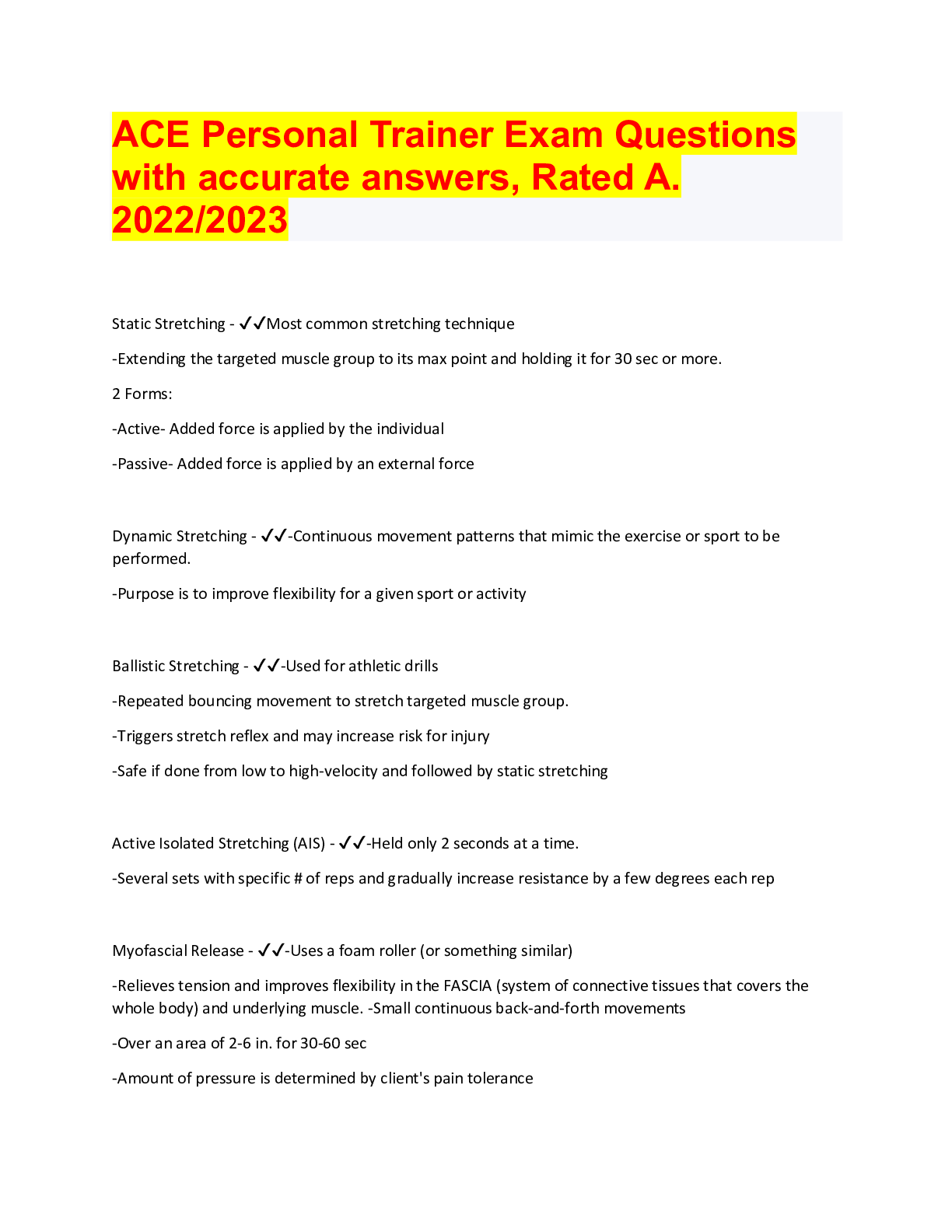
Buy this document to get the full access instantly
Instant Download Access after purchase
Add to cartInstant download
We Accept:

Also available in bundle (1)

ACE Exams bundle, Questions with accurate answers, 2022/2023 updates
All ACE Examible questions with accurate answers, Graded A.
By bundleHub Solution guider 1 year ago
$24
6
Reviews( 0 )
$10.00
Document information
Connected school, study & course
About the document
Uploaded On
Sep 19, 2022
Number of pages
34
Written in
Additional information
This document has been written for:
Uploaded
Sep 19, 2022
Downloads
0
Views
125












